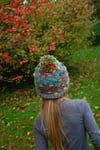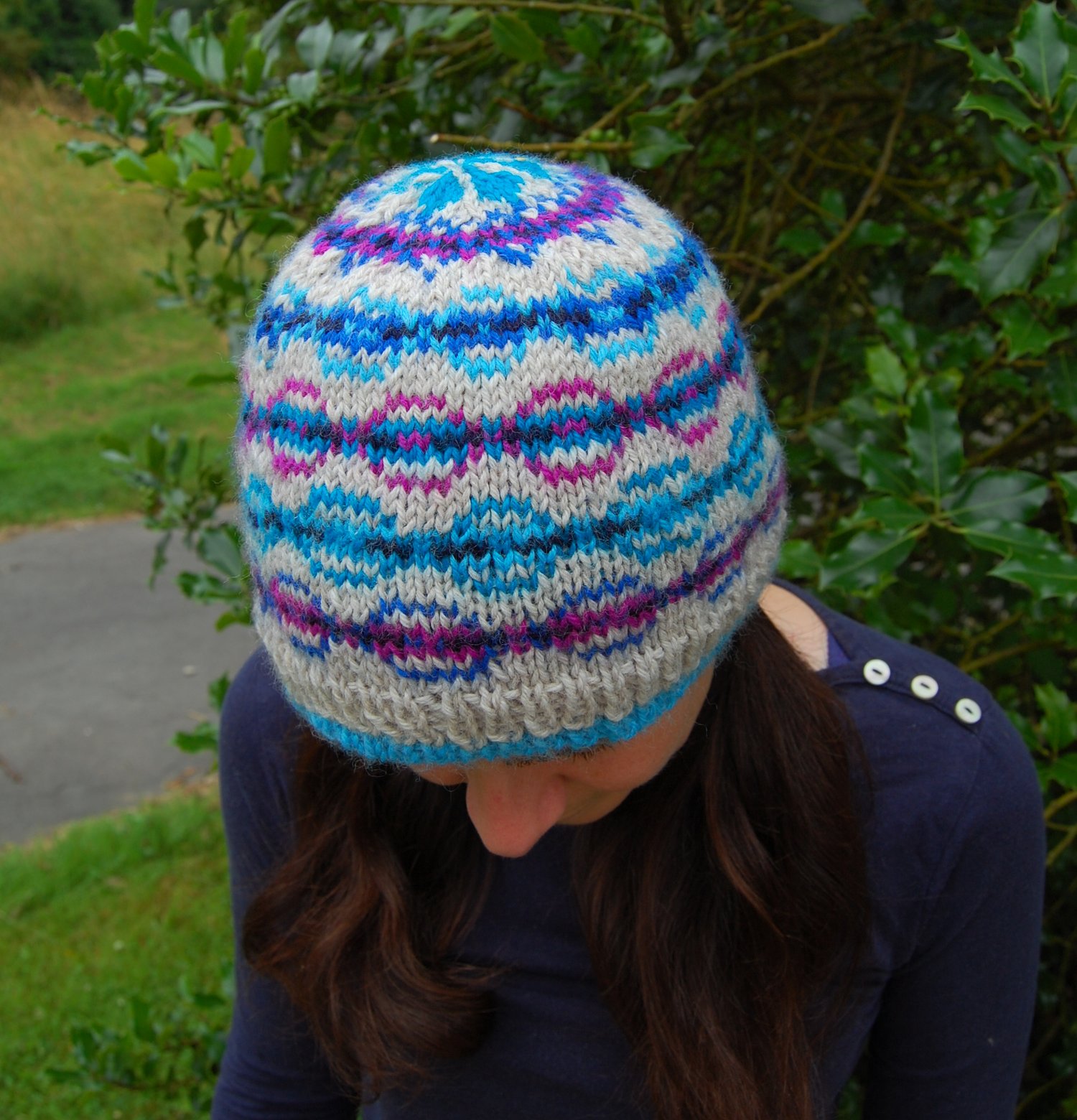Candy Buttons
On Sale
£4.00
£4.00
Super fun, slightly slouchy hat made with stranded colourwork technique. Ideal for using up the end of a pretty handspun or a bright variegated yarn.
Yarn choices
The Adriafil DK Knitcol contrast yarn I chose has short colour repeats (think self-striping sock yarn) so that the “buttons” change colour a couple of times a row. There are many delicious colourways of this yarn to match any background colour, some of which would be ideal for a boy version with camouflage colours or more masculine tones.
You don’t have to match the gauge of your main yarn, with your contrast yarn so you can use a thinner or thicker yarn if you have a particular yarn you want to use. This will be equally fun with a solid contrast yarn or one with less variability in colour. You can even use tiny scraps of different yarns for each button (as shown by the version by tester ftmhling, who used leftovers of different variegated yarns) though you will obviously have more ends to weave in. And if you want a really fun version why not try a novelty yarn for your contrast yarn - as in this project which used an eyelash yarn to make buttons that look more like flowers.
The main yarn I used was a Studio Donegal tweed, and close up has flecks of colour that echo those in the contrast yarn. This is not essential, but is pleasing.
You can also make a completely one-colour version, using your main yarn to make the buttons (see my chocolate buttons version).This would be easy even for a beginner.
Gauge
For reference I’m a pretty loose knitter, so most knitters will want a larger needle than the one I used which is the needle stated in the pattern.
Notions
A circular needle (or dpns) of a size required to obtain gauge
A cable needle or spare dpn
Skills required
The ability to calculate gauge, knit in the round, increase and decrease are assumed.
Instructions and links to tutorials are included for the cast on method and a super-quick and easy way to make a bobble with just your hands. The “candy button” pattern has full written instructions and a chart. A link is also provided to a tutorial on how to carry floats across the back of your work for the stranded colourwork if you have not done this before.
Sizing
If your recipient is at the smallest end of the spectrum or you want a hat that fits more like a beanie it is easy enough to remove a repeat or two of the main pattern to make this a bit smaller and start the decreases a little earlier to shorten it. The reverse is of course true if you want a bigger hat. Please note however that you will need to calculate your own stitch counts, and for much larger or smaller sizes space these over more or fewer rows.
Yarn weight
Aran / 10 ply (8 wpi) ?
Gauge
17 stitches = 10 cm in main candy button pattern using both yarns
Needle size
US 3 - 3.25 mm
Yardage
200 yards (183 m)
Sizes
18 months- 4 years (40cm/15 3/4 in finished circ), 4 years-small adult (50cm/19 3/4 in finished circ)
Yarn choices
The Adriafil DK Knitcol contrast yarn I chose has short colour repeats (think self-striping sock yarn) so that the “buttons” change colour a couple of times a row. There are many delicious colourways of this yarn to match any background colour, some of which would be ideal for a boy version with camouflage colours or more masculine tones.
You don’t have to match the gauge of your main yarn, with your contrast yarn so you can use a thinner or thicker yarn if you have a particular yarn you want to use. This will be equally fun with a solid contrast yarn or one with less variability in colour. You can even use tiny scraps of different yarns for each button (as shown by the version by tester ftmhling, who used leftovers of different variegated yarns) though you will obviously have more ends to weave in. And if you want a really fun version why not try a novelty yarn for your contrast yarn - as in this project which used an eyelash yarn to make buttons that look more like flowers.
The main yarn I used was a Studio Donegal tweed, and close up has flecks of colour that echo those in the contrast yarn. This is not essential, but is pleasing.
You can also make a completely one-colour version, using your main yarn to make the buttons (see my chocolate buttons version).This would be easy even for a beginner.
Gauge
For reference I’m a pretty loose knitter, so most knitters will want a larger needle than the one I used which is the needle stated in the pattern.
Notions
A circular needle (or dpns) of a size required to obtain gauge
A cable needle or spare dpn
Skills required
The ability to calculate gauge, knit in the round, increase and decrease are assumed.
Instructions and links to tutorials are included for the cast on method and a super-quick and easy way to make a bobble with just your hands. The “candy button” pattern has full written instructions and a chart. A link is also provided to a tutorial on how to carry floats across the back of your work for the stranded colourwork if you have not done this before.
Sizing
If your recipient is at the smallest end of the spectrum or you want a hat that fits more like a beanie it is easy enough to remove a repeat or two of the main pattern to make this a bit smaller and start the decreases a little earlier to shorten it. The reverse is of course true if you want a bigger hat. Please note however that you will need to calculate your own stitch counts, and for much larger or smaller sizes space these over more or fewer rows.
Yarn weight
Aran / 10 ply (8 wpi) ?
Gauge
17 stitches = 10 cm in main candy button pattern using both yarns
Needle size
US 3 - 3.25 mm
Yardage
200 yards (183 m)
Sizes
18 months- 4 years (40cm/15 3/4 in finished circ), 4 years-small adult (50cm/19 3/4 in finished circ)



























